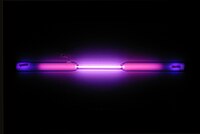
Photo from wikipedia
Abstract Amorphous carbon thin films with high hardness and wear resistance have become increasingly popular for surface engineering of materials for an array of applications ranging from cutting tools to… Click to show full abstract
Abstract Amorphous carbon thin films with high hardness and wear resistance have become increasingly popular for surface engineering of materials for an array of applications ranging from cutting tools to biomedical devices. For any practical application, such carbon films must resist delamination from the substrate under load. High power impulse magnetron sputtering (HiPIMS) provides an opportunity to fabricate carbon films with a wide range of sp3 fractions and thus with tuned mechanical properties. Here we used a process of mixed mode HiPIMS with transition to arc to deposit amorphous carbon films with high hardness-to-elasticity (H/E) ratio, a parameter that is often used as a measure of wear resistance. We tuned the deposition rate and the content of argon in the films by varying either the frequency of HiPIMS pulses or the substrate-to-target distance. In both cases, the argon content increased with increases in the deposition rate. Increasing deposition rate and argon content, increased the H/E ratio, while the sp3 fraction and residual stress decreased. Our results suggest that argon bombardment in a mixed mode HiPIMS process induces a dynamic annealing effect in the carbon films. We showed that H/E does not vary substantially with increasing substrate temperature alone, while the stress decreases for temperatures higher than 120 °C. Deposition at high frequencies is therefore recommended as a practical approach for the synthesis of wear resistant films, as determined by the H/E ratio.
Journal Title: Thin Solid Films
Year Published: 2019
Link to full text (if available)
Share on Social Media: Sign Up to like & get
recommendations!